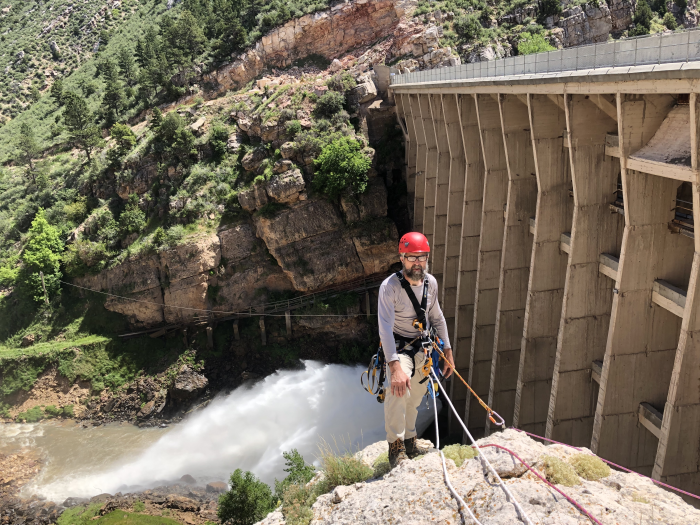







Located beneath a steep canyon near Douglas, Wyoming sits LaPrele Dam, privately owned by LaPrele Irrigation District. Completed in 1909, LaPrele is an open-backed, Ambursen-style concrete dam that measures 41.8 meters (137 feet) high, 99.1 meters (325 feet) long, and holds back an estimated 25 million cubic meters (20,000 acre-feet) of water.
The dam’s canyon location presents natural challenges, particularly weathered, broken rocks surrounding its structure. During a spillway overflow in 2017, a large rock block fell onto the talus slope just downstream of the dam. Several other large boulders are in positions that threaten the structural integrity of the dam. The largest boulder weighs an estimated 185,973 kilograms (410,000 pounds) and could potentially impact a dam pillar if it fell.
RESPEC teamed with dam engineers at HDR and initiated a study in 2018 to evaluate the structural integrity of the dam and develop a risk model for the large rock blocks located above the dam. RESPEC mapped the blocks on both canyon walls using rope-access techniques. A dam inspection revealed several cracks in the structure, and sample analysis from coring revealed weak and weathered concrete. As a result, the engineering team recommended monitoring crack width at five locations and monitoring displacement of the most threatening rock block on the canyon wall.
To accomplish this task, RESPEC used a Campbell Scientific CR300 data-acquisition system. This system measures crack width by using Geokon vibrating wire micro crackmeters and rock block displacement with a custom string extensometer. To address the challenges of the dam’s orientation and difficulties with ice, RESPEC selected a Campbell Scientific CCFC camera to estimate water levels behind the dam.
For remote communication, the monitoring system uses the Campbell Scientific CELL205 cellular module, and data is transferred to the Eagle.io web platform where clients and engineers can be alerted if values exceed specified thresholds. The state of Wyoming recently installed a temporary pressure transducer in the dam reservoir. Data from the transducer will be used to determine if there is a correlation between pool level and width of the dam cracks. RESPEC and HDR will use these data to supplement the structural integrity analysis and monitor the status of the dam to ensure safety for those on and downstream of the site.